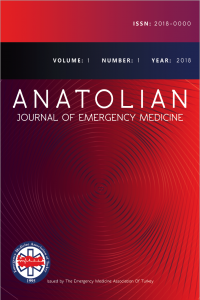Abstract
Medical blogs are very popular means in terms of sharing information and
experience on a given subject. EMAT®Toxicology working group has been
publishing toxicology blog. This article is a retrospective research on the
publishments of the blog in terms of readers’ habits. The results are presented
in a qualitative manner. All together; data is about 75 blog articles and posts
that have been published for 481 days. Our results suggest that the blog posts
which are about current popular public health issues are read more than
classical management of the patients.
Keywords
References
- 1. B. Thoma, T. M. Chan, Q.S. Paterson, et al. Emergency Medicine and Critical Care Blogs and Podcasts: Establishing an International Consensus on Quality. Ann Emerg Med. Volume 66, Issue 4, (2015), Pp 396-402.e4
- 2. B. Thoma, T. M.Chan, P. Kapur, et al. The Social Media Index as an Indicator of Quality for Emergency Medicine Blogs: A METRIQ Study. Ann Emerg Med. https://doi.org/10.1016/j.annemergmed.2018.05.003Ge
- 3. M. Cadogan, B. Thoma, T.M. Chan, et al. Free open access meducation (FOAM): the rise of emergency medicine and critical care blogs and podcasts (2002-2013) Emerg Med J, 31 (2014), pp. e76-e77
- 4. C.P. Nickson, M.D. Cadogan. Free open access medical education (FOAM) for the emergency physician. Emerg Med Australas, 26 (2014), pp. 76-83
- 5. E. Purdy, B. Thoma, J. Bednarczyk, et al.The use of free online educational resources by Canadian emergency medicine residents and program directorsCJEM, 17 (2015), pp. 101-106
- 6. M. Mallin, S. Schlein, S. Doctor, et al.A survey of the current utilization of asynchronous education among emergency medicine residents in the United States. Acad Med, 89 (2014), pp. 598-601
- 7. F.J. Grajales III, S. Sheps, K. Ho, et al.Social media: a review and tutorial of applications in medicine and health care J Med Internet Res, 16 (2014), p. e13
Abstract
Tıp blogları belirli bir konu
hakkında bilgiyi ve deneyimi paylaşmak için popular yöntemlerdir.
TATD®Toksikoloji çalışma grubu toksikoloji bloğu yayınlamaktadır. Bu makale
okurların okuma alışkanlıklarını göz önüne alarak blogda yayınlanmış yazıların
retrospektif araştırmasıdır. Sonuçlar kalitatif olarak sunulmuştur. Tümüne
bakıldığında 481 gün boyunca yayınlanmış 75 blog makalesi ve postası mevcuttur.
Sonuçlarımıza göre popular halk sağlığı ile ilgili konularda yazılan blog yazıları
klasik hasta tedavisi hakkındaki yazılardan daha fazla okunmaktadır.
Keywords
References
- 1. B. Thoma, T. M. Chan, Q.S. Paterson, et al. Emergency Medicine and Critical Care Blogs and Podcasts: Establishing an International Consensus on Quality. Ann Emerg Med. Volume 66, Issue 4, (2015), Pp 396-402.e4
- 2. B. Thoma, T. M.Chan, P. Kapur, et al. The Social Media Index as an Indicator of Quality for Emergency Medicine Blogs: A METRIQ Study. Ann Emerg Med. https://doi.org/10.1016/j.annemergmed.2018.05.003Ge
- 3. M. Cadogan, B. Thoma, T.M. Chan, et al. Free open access meducation (FOAM): the rise of emergency medicine and critical care blogs and podcasts (2002-2013) Emerg Med J, 31 (2014), pp. e76-e77
- 4. C.P. Nickson, M.D. Cadogan. Free open access medical education (FOAM) for the emergency physician. Emerg Med Australas, 26 (2014), pp. 76-83
- 5. E. Purdy, B. Thoma, J. Bednarczyk, et al.The use of free online educational resources by Canadian emergency medicine residents and program directorsCJEM, 17 (2015), pp. 101-106
- 6. M. Mallin, S. Schlein, S. Doctor, et al.A survey of the current utilization of asynchronous education among emergency medicine residents in the United States. Acad Med, 89 (2014), pp. 598-601
- 7. F.J. Grajales III, S. Sheps, K. Ho, et al.Social media: a review and tutorial of applications in medicine and health care J Med Internet Res, 16 (2014), p. e13
Details
| Primary Language | English |
|---|---|
| Journal Section | Original Articles |
| Authors | |
| Publication Date | September 21, 2018 |
| Published in Issue | Year 2018 Volume: 1 Issue: 1 |


